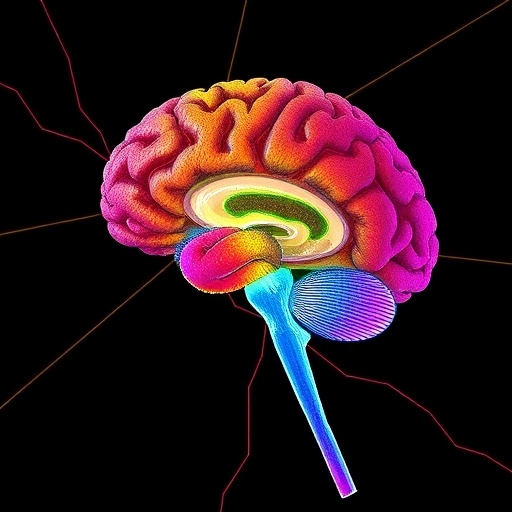In a groundbreaking study published in Translational Psychiatry, researchers have unveiled the pivotal role of Transcription Factor 4 (TCF4) in orchestrating the complex process of corpus callosum formation through the regulation of neuron–astroglia communication. This work sheds new light on the intricate molecular and cellular mechanisms that guide the interhemispheric midline remodeling, offering significant implications for understanding developmental brain disorders associated with callosal malformations.
The corpus callosum, the largest white matter structure in the mammalian brain, serves as a vital bridge for communication between the left and right cerebral hemispheres. Its formation involves an elaborate series of cellular events culminating in the remodeling of the interhemispheric midline, where the precise interplay between neurons and glial cells is essential. Despite the critical functions of the corpus callosum, the transcriptional regulators and signaling cascades that modulate its development have remained poorly understood.
Zeng et al. have meticulously dissected the role of TCF4, a key transcription factor previously implicated in neurodevelopmental and psychiatric disorders, in mediating the communication network between neurons and astroglia during corpus callosum morphogenesis. Their findings provide compelling evidence that TCF4 controls the expression of genes crucial for the intercellular dialogue that shapes the midline remodeling events necessary for proper callosal assembly.
The study unveils a previously uncharacterized pathway where TCF4 modulates signals from neurons that instruct adjacent astroglia to adopt a specialized phenotype supportive of axonal guidance and midline remodeling. This neuron-to-astroglia signaling axis appears indispensable for the generation of a permissive microenvironment, facilitating the navigation and crossing of commissural axons through the midline.
Leveraging cutting-edge genetic models and cell type-specific manipulations, the research team revealed that conditional deletion of TCF4 in cortical neurons disrupts astroglial maturation and impairs the formation of the corpus callosum. Such manipulations also led to aberrant midline architecture and axonal misrouting, hallmark features reminiscent of human corpus callosum agenesis.
Critically, their transcriptomic analyses illuminated a network of downstream effectors regulated by TCF4, many of which have established roles in cell adhesion, extracellular matrix remodeling, and signaling pathways integral to glial function and axonal guidance. This molecular insight reinforces the notion that TCF4 acts as a master regulator orchestrating a coordinated gene expression program tailored for midline structural remodeling.
Furthermore, in vitro co-culture experiments demonstrated that neurons lacking TCF4 failed to elicit typical astroglial responses, underscoring the requirement of TCF4-dependent neuronal signaling for astrocyte function. This discovery accentuates the dynamic bidirectional crosstalk between neurons and astroglia that underlies developmental plasticity and tissue remodeling in the embryonic brain.
Importantly, the study’s findings carry far-reaching implications for understanding the etiology of callosal malformations observed in a spectrum of neurodevelopmental disorders, including autism spectrum disorder, schizophrenia, and intellectual disability. Given TCF4’s association with these conditions, elucidating its mechanistic role offers new avenues for therapeutic exploration targeting neuron-glia interactions.
The authors further discuss the potential for TCF4-driven interventions aimed at restoring or enhancing neuron-astroglia communication to ameliorate callosal deficits or prevent their onset during early brain development. Such strategies could revolutionize approaches to mitigating the neuroanatomical abnormalities that contribute to cognitive and behavioral dysfunctions related to callosal pathologies.
Another intriguing aspect of the study is the demonstration that astroglial cells, far from being passive structural elements, actively respond to neuronal cues mediated by TCF4, adopting context-specific roles that enable the physical remodeling of the interhemispheric midline. This challenges previous paradigms and expands our understanding of astrocyte plasticity during brain development.
The research also highlights the temporal specificity of TCF4 function, as its activity is most critical during a defined developmental window when the corpus callosum is being established. Disruption outside this window appears to have less pronounced effects, suggesting a tight developmental regulation of this transcriptional module.
To validate their observations, the researchers employed advanced imaging techniques, including fluorescence microscopy combined with three-dimensional reconstruction, providing detailed visualization of midline remodeling events and astroglial morphology. This integrative approach corroborates the molecular and functional findings, painting a comprehensive picture of TCF4’s role.
Moreover, the study raises fascinating questions about how TCF4 integrates extrinsic signaling pathways and intrinsic transcriptional programs to coordinate complex developmental processes. Future research inspired by these findings may unravel additional layers of regulatory complexity governing brain midline formation.
In conclusion, this seminal work by Zeng and colleagues illuminates a novel regulatory axis centered on TCF4 that governs neuron-astroglia communication essential for corpus callosum development. Their findings not only deepen fundamental insights into neurodevelopmental biology but also open promising therapeutic vistas for disorders rooted in callosal dysgenesis.
As our understanding of the molecular orchestration of brain wiring advances, this study stands out as a landmark contribution that bridges the gap between transcriptional regulation and cellular interactions at the heart of interhemispheric connectivity. The revelation of such targeted gene networks provides a blueprint for future interventions aimed at rescuing or preventing callosal malformations with precision and efficacy.
This pioneering research underscores the indispensable role of transcription factors like TCF4 in sculpting the brain’s architectural and functional integrity. More broadly, it exemplifies the power of integrating genetic, molecular, and imaging tools to unravel the complexities of neural circuit formation, heralding a new era in developmental neuroscience.
Subject of Research: The role of transcription factor 4 (TCF4) in regulating neuron–astroglia communications during the formation of the corpus callosum and its impact on interhemispheric midline remodeling.
Article Title: Transcription factor 4 regulates the interhemispheric midline remodeling through neuron–astroglia communications during corpus callosum formation.
Article References:
Zeng, L., Zhang, Y., Zhu, Y. et al. Transcription factor 4 regulates the interhemispheric midline remodeling through neuron–astroglia communications during corpus callosum formation. Transl Psychiatry 15, 482 (2025). https://doi.org/10.1038/s41398-025-03696-7
Image Credits: AI Generated
DOI: 18 November 2025




